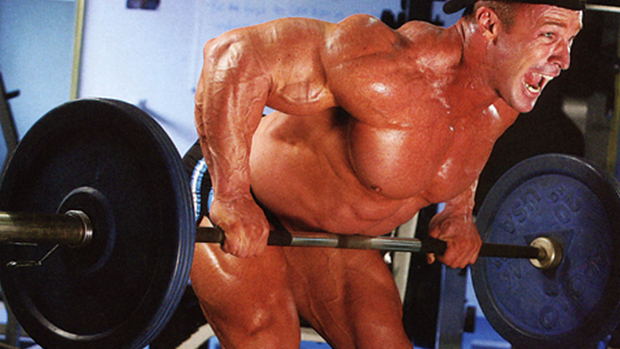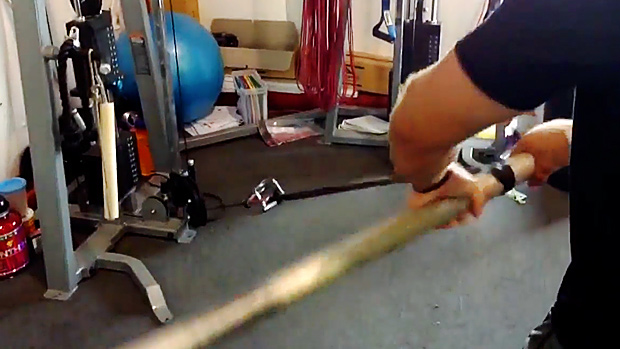If I've seen it once, I've seen it a hun– ...
well, a bunch of times. A personal trainer or strength and
conditioning specialist will make an assertion about preparing
competitive athletes that goes against everything I've learned
as an athlete and coach. And none of his peers will argue with him.
Before I get into the five myths, let me assure you that I do,
in fact, train competitive athletes. A sprinter I work with, Darvis
Patton, is heading to Beijing to represent the U.S. in the 100
meters and the 4 x 100 relay. I also work with major-league
baseball players and other elite athletes, and over the past 11
years I've worked with hundreds of clients from all walks of
life.

Darvis Patton, U.S. Olympic
sprinter
I've also competed in bodybuilding, powerlifting, and
Strongman competitions, and incorporate some of each in my training
programs. Which brings me to ...
Myth #1: "You should train movements, not
muscles."
Ten years ago, when I worked as a trainer and massage therapist
in a chiropractic clinic, I learned something important: The human
body will always find a way to achieve a desired movement.
That movement may be dysfunctional, but your body is going to
get it done. If there's a structural weakness, it will
compensate by altering its gait or posture. The human body is wired
for survival, not four-minute miles or 400-pound bench presses.
Let's use powerlifting as an example: As a former
competitor, I've seen people lift massive weights with the
worst technique you can imagine. If training movements really
matters more than training muscles, the ones with the best form
should've won and the ones with the worst form should've
lost. Instead, the ones with the strongest muscles won. Sometimes
they also had great form, but often they didn't.
Strength, in my experience, never improves in a systemic, linear
way. In just about any compound movement, performance will improve
when you identify and strengthen the weakest muscle group within
that movement. That's why a powerlifter might be able to add
25 pounds to his bench press by increasing strength in his triceps.
Similarly, strengthening your lower trapezius and serratus anterior
can add several pounds to your overhead press.
We must focus on the prime movers in any action that's
crucial to athletic performance, whether we're talking about
running, jumping, or hitting a baseball. Improve the function of
those muscles, and you improve the athlete.
Myth #2: "Single-joint movements are useless for
athletes."
If I asked you this – "Can weakness in a single
muscle decrease performance?" – you'd say
"yes." We all know this. And yet, the idea of using
single-joint movements to strengthen specific muscles is widely
disparaged.
That said, it's not always obvious where the weakness is,
or the best way to fix it once we find it. That's why physical
therapists, chiropractors, strength coaches, and other rehab
specialists have jobs.
My point is that we have hundreds of exercises to select from
when we design training programs. We shouldn't eliminate an
entire category of exercises – you never know when
they'll come in handy.
Myth #3: "Olympic lifts and plyometrics are necessary to
improve rate of force development."
Countless strength coaches believe that in order to be fast you
must train fast. That's why Olympic lifts are staples in
athletic training.
I don't see it that way. Rate of force development is
movement-specific, involving a combination of reaction time,
maximal strength, flexibility, coordination, and familiarity with
the task. Of those qualities, at least two are somewhat genetic
– you either have great coordination and reaction time, or
you don't. They're among the least trainable qualities
athletes need to succeed.
On the other hand, strength is the most trainable of all
athletic qualities. That's where coaches need to focus in the
weight room. And I'll be even more specific: In my experience,
the eccentric strength of the antagonist muscles is what limits the
ability of the prime movers to produce speed and
power.
Take a pitcher in baseball. The more eccentric strength he has
in the external rotators of his shoulder, the more pitches
he'll be able to throw, and the more often he'll be able
to throw them.
With sprinters, I've had a lot of success by emphasizing
the eccentric strength of the hamstrings.
The hamstrings have a dual role in sprinting: they're the
prime movers – the agonists – during propulsion. That
is, they combine with the other posterior-chain muscles to make you
go. But when you're recovering from that part of the running
motion, they're the antagonists to the hip-flexor muscles,
which are responsible for pulling your thigh up toward your chest.
We call this the "late swing phase" of the sprint cycle,
and it's when most hamstring injuries occur.
In other words, the hamstrings are most likely to get injured
when they're working eccentrically, as the antagonists to the
hip-flexor muscles. My job as a coach is to increase the eccentric
strength of the hamstrings in the sprinters I train.
With Darvis Patton, I like to use a semi-stiff-legged deadlift
with a 40X1 tempo – four seconds to lower the weight to the
floor, no pause, an explosive lift, and a one-second pause at the
top. He can do five reps with 405 pounds, which is pretty
impressive for a drug-free athlete who's six feet tall and
weighs just 174 pounds. We also use trap-bar deadlifts and podium
deadlifts, but no box jumps, power cleans, or power
snatches.
It's certainly worked for Darvis. In 2006 his best time in
the 100 meters was 10.27 seconds. This year it's 9.89.
Myth #4: "Full body routines are great for building muscle
mass."
I started my amateur bodybuilding career at an athletic 158
pounds, and in 10 years built a physique that was very lean at 207.
I used split routines, like everyone else I knew back then. In
fact, when I started in the early '90s, I didn't know
people did full-body routines. Today, I don't know of any
contemporary bodybuilders or powerlifters who use full-body
programs. Westside Barbell protocols are popular for a reason: they
work.
But where's the evidence that full-body routines work? I
understand that full-body routines were popular during the golden
era of Muscle Beach, but most of those guys were nowhere near the
size of the current crop of drug-free bodybuilders. Bodybuilders
started getting bigger in the '50s and '60s by using
split routines, like those advocated by Vince
Gironda.
I use full-body routines for clients who aren't trying to
gain significant amounts of muscle, including business
professionals who travel frequently, in-season athletes, and some
of the women I train. In my experience, the average male will make
gains for about six to eight weeks before his body adapts to the
routine and progress halts.
Impressive gains in muscle hypertrophy require at least four
days a week of resistance training. Your muscles need more tension
and volume to make further adaptations. You can't accomplish
that if you're training three hours a week and trying to hit
all your major muscles in every workout. You simply don't have
the time to do it.
Myth #5: "Agility training is the best way to improve
on-field performance."
When an athlete's sport requires a high level of agility,
he needs to be as lean as possible.
If a male athlete carries more than 12 percent body fat,
I'll address that. Same with a female athlete with more than
20 percent body fat. I consider them fat-ass athletes. Now, there
are many great fat-ass athletes in professional sports. There are
also great athletes that are alcoholics and drug addicts. But just
because they can maintain a high level of performance doesn't
mean they wouldn't be better if they were leaner. If nothing
else, they'll probably be less likely to suffer knee injuries.
Improving an athlete's strength-to-weight ratio –
that is, making him leaner at the same body weight without
sacrificing any of his strength – improves not only his
agility, but also his speed, work capacity, force-generating
capabilities, and overall on-field performance.
Take a defensive back who weighs 195 pounds at 10 percent body
fat. Drop his body-fat to 6 percent while maintaining or increasing
his strength and muscle mass, and you have a better athlete.
So those are my pet peeves about contemporary training methods.
What are yours?





